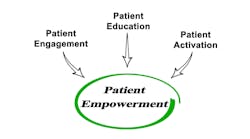Working Group Seeks Widespread Clinical Decision Support Implementation for Opioid Care by 2021
An Opioid Action Plan developed by a working group of the Patient-Centered Clinical Decision Support (PCCDS) Learning Network has set an ambitious goal of delivering PCCDS interventions that improve pain management and opioid use outcomes for 2 million patients by 2021. Provider organizations such as Kaiser Permanente and the Veterans Administration have already started using its framework to develop tools.
The working group, co-chaired by consultant Jerry Osheroff, M.D., and Barry Blumenfeld, M.D., a senior physician informaticist at RTI International, kicked off in April 2018. It has developed five scenarios in which clinical decision support could be helpful and described 19 PCCDS interventions that could be implemented.
The scenarios envision clinicians using order sets, registries, prescription drug monitoring programs and shared decision-making tools with patients to identify evidence-informed, non-opioid interventions to try. They also foresee patient using mobile tools to document progress, support adherence to a plan, and address questions and issues that arise.
“We want to see these future scenarios and PCCDS interventions widely and successfully implemented,” Osheroff said. Patient involvement in decision making is central to the effort. “The raison d’etre of the Learning Network is working toward a world where clinicians and patients are working together on shared care plans and shared decision making.”
Although many of the interventions the working group describes exist in some provider organizations, few are widespread yet, Blumenfeld said. “The current state is rapidly changing and is pretty nascent,” he added. The CDC published guidelines for opioids and pain management two years ago and those are just beginning to filter out as actual CDS artifacts from organizations such as ONC and CDS Connect. “There are isolated islands of activity at the moment, and I think many people are hoping for that to change quite quickly,” he noted, adding that Congress recently passed an opioid bill that has health IT components to it.
The working group presented its work recently at the annual meeting of the Learning Network and is preparing to issue a report in January. That report will contain a roadmap and plan detailing scenarios, high-value interventions, recommendations, and descriptions of the coordinated actions being taken by stakeholders.
Among the interventions that drew the most interest at the meeting was a dashboard to characterize what type of opioid use or pain management history a patient has had, what their functional status is, and what their response to different treatments has been.
Osheroff said there were two big takeaways from the feedback received at the meeting: One was that the scenarios the working group developed are compelling ones to patient advocates, providers and EHR developers. Another was that people involved in the process would like to see the collaboration, dialog and sharing that took place among working group participants continue in some type of ongoing forum.
“We actually found that there are already activities being undertaken that represent early implementations or progress toward making those scenarios a widespread reality,” Osheroff said. EHR vendors that are participating in the working group have started using the scenarios as use cases for their product development, he added. Kaiser, Epic and EBSCO are in talks about developing and implementing certain kinds of interventions together.
Provider organizations are starting to use the scenarios to paint a picture about how their work can move things toward the aspirational goal, Osheroff added. “One huge thing that happened was that Jonathan Nebeker, deputy CMIO for the VA, stood up at the meeting and said the work we have already done has started to affect how the VA is approaching this issue.”
Osheroff admits the goal of reaching 2 million patients with these interventions by 2021 is quite ambitious. “We said, ‘Let’s put a marker out there that says this is what we are trying to accomplish.’ The audience for that is the change agents within each of these stakeholder groups who are in a position to move the ball closer to that desired aim. We want them to take steps to make these interventions more widespread and helpful than they are today or would otherwise be without this document having been produced.”
“We don’t want this to be a report that sits on a shelf,” Blumenfeld added. “It is a living initiative we hope will snowball and gain momentum as more stakeholders commit to specific actions to move this forward.”


